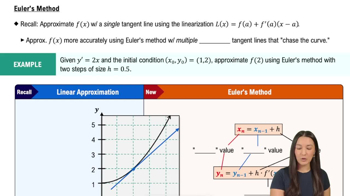Evaluate the integral. (Use c for the constant of integration.)
Table of contents
- 0. Functions7h 54m
- Introduction to Functions16m
- Piecewise Functions10m
- Properties of Functions9m
- Common Functions1h 8m
- Transformations5m
- Combining Functions27m
- Exponent rules32m
- Exponential Functions28m
- Logarithmic Functions24m
- Properties of Logarithms36m
- Exponential & Logarithmic Equations35m
- Introduction to Trigonometric Functions38m
- Graphs of Trigonometric Functions44m
- Trigonometric Identities47m
- Inverse Trigonometric Functions48m
- 1. Limits and Continuity2h 2m
- 2. Intro to Derivatives1h 33m
- 3. Techniques of Differentiation3h 18m
- 4. Applications of Derivatives2h 38m
- 5. Graphical Applications of Derivatives6h 2m
- 6. Derivatives of Inverse, Exponential, & Logarithmic Functions2h 37m
- 7. Antiderivatives & Indefinite Integrals1h 26m
- 8. Definite Integrals4h 44m
- 9. Graphical Applications of Integrals2h 27m
- 10. Physics Applications of Integrals 3h 16m
- 11. Integrals of Inverse, Exponential, & Logarithmic Functions2h 34m
- 12. Techniques of Integration7h 41m
- 13. Intro to Differential Equations2h 55m
- 14. Sequences & Series5h 36m
- 15. Power Series2h 19m
- 16. Parametric Equations & Polar Coordinates7h 58m
7. Antiderivatives & Indefinite Integrals
Integrals of Trig Functions
Problem 5.R.51
Textbook Question
Evaluating integrals Evaluate the following integrals.
∫ 𝓍² cos 𝓍³ d𝓍
 Verified step by step guidance
Verified step by step guidance1
Step 1: Recognize that the integral ∫𝓍² cos(𝓍³) d𝓍 involves a composite function. This suggests that substitution might be a useful method to simplify the integral.
Step 2: Let u = 𝓍³. Then, compute the derivative of u with respect to 𝓍: du/d𝓍 = 3𝓍², which implies du = 3𝓍² d𝓍.
Step 3: Rewrite the integral in terms of u. Substitute u = 𝓍³ and du = 3𝓍² d𝓍 into the integral. The integral becomes (1/3) ∫cos(u) du, where the factor of 1/3 comes from dividing by 3 to account for the substitution.
Step 4: Evaluate the integral of cos(u) with respect to u. The integral of cos(u) is sin(u). Thus, the integral becomes (1/3) sin(u) + C, where C is the constant of integration.
Step 5: Substitute back u = 𝓍³ to express the solution in terms of the original variable 𝓍. The final result is (1/3) sin(𝓍³) + C.
 Verified video answer for a similar problem:
Verified video answer for a similar problem:This video solution was recommended by our tutors as helpful for the problem above
Video duration:
2mPlay a video:
Was this helpful?
Key Concepts
Here are the essential concepts you must grasp in order to answer the question correctly.
Integration
Integration is a fundamental concept in calculus that involves finding the integral of a function, which represents the area under the curve of that function on a given interval. It can be thought of as the reverse process of differentiation. There are various techniques for integration, including substitution, integration by parts, and numerical methods, each suited for different types of functions.
Recommended video:

Integration by Parts for Definite Integrals
Substitution Method
The substitution method is a technique used in integration to simplify the process by changing the variable of integration. This involves substituting a part of the integrand with a new variable, which can make the integral easier to evaluate. For example, in the integral ∫ x² cos(x³) dx, one might let u = x³, which simplifies the integral significantly.
Recommended video:

Euler's Method
Trigonometric Functions
Trigonometric functions, such as sine and cosine, are fundamental functions in mathematics that relate angles to ratios of sides in right triangles. In calculus, these functions often appear in integrals and derivatives. Understanding their properties, such as periodicity and symmetry, is crucial for evaluating integrals that involve trigonometric expressions, like cos(x³) in the given integral.
Recommended video:

Introduction to Trigonometric Functions

 5:28m
5:28mWatch next
Master Integrals Resulting in Basic Trig Functions with a bite sized video explanation from Patrick
Start learningRelated Videos
Related Practice
Multiple Choice
31
views
